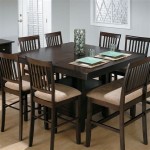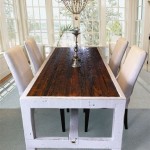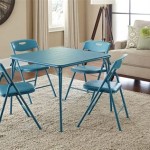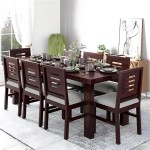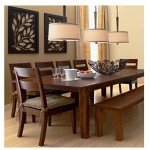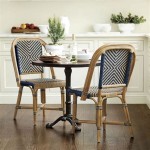Bench Seating For Dining Tables: A Comprehensive Guide
Bench seating for dining tables has experienced a resurgence in popularity, moving from a purely functional approach to becoming a stylish and versatile element in contemporary dining spaces. This seating option offers a unique blend of practicality and aesthetic appeal, capable of transforming the ambiance of a dining area. This article explores the multifaceted aspects of bench seating for dining tables, covering its advantages, considerations, different styles, materials, sizing guidelines, and care instructions.
Advantages of Bench Seating
One of the primary appeals of bench seating is its space-saving capability. In smaller dining areas, benches can be tucked neatly under the table when not in use, freeing up valuable floor space and creating a more open feel. Traditional chairs, with their individual footprints, often occupy more space even when pushed in.
Bench seating can accommodate more people than individual chairs in the same linear space. This is particularly advantageous for families with children or for those who frequently host gatherings. The flexibility of bench seating allows for easy squeezing in of extra guests without the need to add additional chairs.
Many find bench seating to be a visually appealing alternative to the standard arrangement of chairs. Benches introduce a more casual and relaxed atmosphere to the dining area, fostering a communal and inviting environment. They can also offer a unique design element that complements various interior styles, from rustic farmhouse to modern minimalist.
Benches often come with built-in storage options, such as drawers or lift-up seats. This feature provides a convenient solution for storing linens, placemats, or other dining essentials, helping to declutter the dining area and maximize space efficiency.
Bench seating can be a more cost-effective option compared to purchasing individual chairs, especially when needing to seat a large number of people. Benches tend to be simpler in construction, which can translate to lower manufacturing costs and therefore, lower prices for the consumer.
Key Considerations When Choosing Bench Seating
Before investing in bench seating, several factors need careful consideration to ensure a comfortable and functional dining experience. The height of the bench in relation to the table is crucial. Ideally, there should be approximately 10 to 12 inches of space between the top of the bench seat and the underside of the table. This allows for comfortable legroom and prevents diners from feeling cramped.
The depth of the bench seat is another important consideration. A seat depth of around 15 to 18 inches is generally recommended for comfortable seating. Deeper benches may require additional back support to prevent slouching and promote good posture. Shorter benches may be suitable for children or for purely aesthetic purposes, but may not be comfortable for adults to sit on for extended periods.
The placement of the bench within the dining space is also important. Consider whether the bench will be placed against a wall or freestanding. Wall-mounted benches can save space and provide back support, while freestanding benches offer more flexibility in terms of placement and can be used on either side of the table.
The style of the bench should complement the existing dining table and the overall design of the dining room. A modern dining table would benefit from a sleek, minimalist bench, while a rustic farmhouse table would pair well with a wooden bench with a distressed finish. Consider the materials, colors, and finishes of the bench to ensure a cohesive and visually appealing look.
Finally, think about the comfort level of the bench. While some benches are designed with purely aesthetics in mind, others prioritize comfort. Consider adding cushions or padding to the bench seat for enhanced comfort, especially if the bench will be used for longer meals or gatherings. Backrests can also significantly improve the comfort level of bench seating.
Styles and Materials of Bench Seating
Bench seating is available in a wide range of styles to suit various design preferences and dining table aesthetics. A classic wooden bench offers a timeless and versatile option that complements a variety of table styles, from traditional to contemporary. Wooden benches can be made from various types of wood, such as oak, maple, walnut, or pine, each offering its own unique grain pattern and color variations.
Upholstered benches provide a more luxurious and comfortable seating experience. These benches feature a padded seat covered in fabric or leather, offering a soft and supportive surface to sit on. Upholstered benches can be customized with a variety of fabrics and colors to match the dining room décor. Leather upholstery offers a durable and sophisticated option, while fabric upholstery provides a wider range of design possibilities.
Modern minimalist benches often feature clean lines, simple shapes, and a focus on functionality. These benches are typically made from materials such as metal, glass, or engineered wood, and are designed to blend seamlessly into contemporary dining spaces. Modern benches often feature a low profile and a minimalist aesthetic, emphasizing simplicity and elegance.
Farmhouse style benches embrace a rustic and charming aesthetic, often featuring distressed finishes, natural wood grain, and handcrafted details. These benches are designed to evoke a sense of warmth and nostalgia, creating a cozy and inviting dining atmosphere. Farmhouse benches often feature turned legs, planked seats, and other traditional design elements.
Industrial style benches combine raw materials, such as metal and wood, to create a rugged and utilitarian aesthetic. These benches often feature exposed metal frames, reclaimed wood seats, and a focus on durability and functionality. Industrial benches are ideal for creating a modern and edgy dining space.
The choice of materials for bench seating is crucial for both aesthetics and durability. Wood offers a classic and versatile option, providing warmth and natural beauty. Metal provides strength and stability, creating a sleek and contemporary look. Upholstery adds comfort and texture, allowing for a wide range of design possibilities. Consider the durability, maintenance requirements, and overall aesthetic of each material when making a decision.
Sizing and Placement Considerations
Accurate sizing is paramount to ensuring the bench fits well with the dining table and allows for comfortable seating. The length of the bench should ideally be slightly shorter than the length of the table to allow for easy access to the bench. A bench that is too long may make it difficult to get in and out of the seating area, while a bench that is too short may not provide adequate seating.
As previously mentioned, the height of the bench also matters. The ideal height is typically around 16 to 18 inches, allowing for comfortable legroom and a proper dining posture. Shorter benches may require diners to hunch over, while taller benches may make it difficult to reach the table comfortably.
When placing a bench against a wall, ensure that there is sufficient space between the wall and the table to allow for comfortable movement. Leave at least 36 inches of space between the edge of the table and the wall to allow diners to easily get in and out of their seats and move around the dining area.
If using two benches on opposite sides of the table, ensure that there is enough space between the benches to allow for comfortable movement. Consider the number of people who will be seated at the table and ensure that there is enough space for everyone to sit comfortably without feeling cramped.
The placement of the bench can also impact the overall flow of the dining room. Consider the placement of doorways, windows, and other furniture when deciding where to position the bench. Avoid blocking pathways or creating obstacles that could impede movement within the dining area.
Care and Maintenance of Bench Seating
Proper care and maintenance are essential for preserving the longevity and appearance of bench seating. The specific care requirements will vary depending on the materials used in the bench's construction.
For wooden benches, regular dusting is recommended to prevent the buildup of dust and dirt. Use a soft cloth or duster to gently wipe down the surface of the bench. Avoid using harsh chemicals or abrasive cleaners, as these can damage the finish of the wood. Periodically apply a wood polish or conditioner to help protect the wood and maintain its luster.
Upholstered benches require regular vacuuming to remove dust, crumbs, and other debris. Use a brush attachment to gently vacuum the surface of the upholstery. For spills and stains, blot the area immediately with a clean, dry cloth. Avoid rubbing the stain, as this can spread it and make it more difficult to remove. Use a mild detergent or upholstery cleaner to gently clean the stain, following the manufacturer's instructions.
Metal benches can be cleaned with a damp cloth and a mild detergent. Avoid using abrasive cleaners or scouring pads, as these can scratch the surface of the metal. For rust or corrosion, use a metal cleaner or rust remover according to the manufacturer's instructions.
Regularly inspect the bench for any signs of damage, such as loose joints, cracks, or tears. Address any issues promptly to prevent further damage and prolong the life of the bench. Tighten any loose screws or bolts, and repair any cracks or tears as needed.
Consider using protective covers or table runners to protect the bench from spills, stains, and scratches. These accessories can help to keep the bench looking its best and prolong its lifespan.

Bench Seating And Dining Table Traditional Room Cleveland By User Houzz

L Shape Corner Seating Dining Set Banquette V Modern Table Etsy Singapore

Deep Buttoned Kitchen Dining Booth Bench Seating In Real Italian Leather Any Colour Etsy Singapore

Woods Adelaide 180cm Dining Table With Corner Bench In Tan Furniture

Pin Page

How To Add Kitchen Banquette Seating With This Bench Tutorial

How To Furnish A Small Dining Room B2c Furniture

Kitchen Design Bench Seating Harvey Jones
:strip_icc()/101517272-c3b05d5f78f24ec8b3a9992775f28826.jpg?strip=all)
Built In Banquette Ideas

Bespoke Bench Seating Made To Measure

